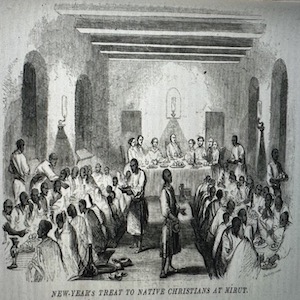Church Missionary Society Periodicals
Church Missionary Society Periodicals illustrates Anglican evangelical missionary work between 1804 and 2009 through an online collection of the publications of the Church Missionary Society (CMS), the South American Missionary Society, and the Church of England Zenana Missionary Society (CEZMS). Founded in 1799 as an Anglican evangelical movement, the CMS has been active across the globe, proving one of the key agents of evangelism in the African and Asian world. The archive contains periodicals (newspapers and journals) and reports documenting the activities and interests of the missionary societies and their various missions throughout the world. These publications served the purpose of informing readers of mission activities, providing updates, instructing, and raising money in support of the missions. The periodicals in this collection are sourced from the Crowther Mission Studies Library at the Church Mission Society (CMS) in Oxford, and the Cadbury Research Library at the University of Birmingham.
The home page of this collection lists six sections at the top of the screen: "Introduction," "Documents," "Explore," "Image Gallery," "Maps," and "Help." The main section "Documents" offers avenues for browsing the collection, such as the CMS periodicals, historical records, and annual reports. Other key documents include the publications of CMS medical mission auxiliaries, and the work of the Church of England Zenana Missionary Society among women in China, India, and Japan. They can also explore The Register of Missionaries, unique annotated volumes listing the men and women of the CMS from 1804-1928. The collection has been thoroughly indexed, and is thus searchable by keyword, title, issue date, society, place of publication, owning library, and copyright information. Each document is represented by a high-quality image that can be examined by zooming in or saved to a personal collection using the "My Lightbox" feature.
The "Image Gallery" and "Maps" sections provide direct access to the archive's rich visual sources, from early woodcut illustrations or engravings to front covers and photos. It can be searched by keyword, and it can also be filtered by image type, date, or keyword. Users can view full-size images of the maps, and images can also be saved to a personal collection. The "Explore" section includes a series of valuable supplementary features. The "Biographies" tab provides a collection of short biographies of the missionaries referenced in the periodicals. The "essays" tab includes critical essays commissioned from experts on the themes highlighted by the resource. Those essays focus on research topics that serve as examples of how the material can be utilized for research purposes. The "Interactive Chronology" tab is a very useful timeline along which users can scroll to see key events with brief descriptions and often pictures. This tab is especially useful for teaching as it can be used to create a printable timeline of events and it can also filtered by category region, and time period.
With publications ranging in period, style, and focus, this resource aims to offer a global view of missionary activity across three centuries and to facilitate research within a vast range of disciplines. Teachers can utilize Church Missionary Society Periodicals as a teaching tool, by having students wrestle with questions of perspective and historiography through the analysis and interrogation of the sources. One of the periodicals, The Missionary Gleaner, provides an example of how the periodicals project provides primary source insights into frequently inaccessible contexts but also creates teaching platforms for the handling of one-sided biased sources. CMS work in Central Kenya began in 1900, while the ensuing decade saw considerable hostility between the British imperialists and the native Bantu ethnic group of the region,the Kikuyu. By 1910, the Uganda Railroad was complete, the railway cut a direct route through the lands of the Kikuyu. A report from 1910 called “The Highlands of the Kikuyu” points out how white settlement demanded a change in cultural customs in favor of missionary teachings, to which the Kikuyu became “violently opposed.”
Excerpts such as this and similar examples in the periodicals, affording students the opportunity to explore how missionary efforts to evangelize faraway people and places often went hand in hand with the larger colonial project, all the while sowing the seeds for nationalist movements later in the century. Noteworthy too is the ignorance of the missionary community when it came to the centrality of land in Kikuyu culture. White settlement was introduced to the region through generous grants of indigenous land. Here the missionaries reflect a Western view of land as simply a medium of exchange and mode of production. But in Kikuyu culture, the acquisition and ownership of land was vital to their traditional definition of manhood and notions of masculinity. Without land a Kikuyu man could not marry and could not become a man. The cultural conflicts between the inhabitants and the white settlers eventually culminated in the violent Mau Mau Rebellion of the 1950s. Church Missionary Society Periodicals afford students the chance to explore the impact of cultural misunderstandings and assumptions on the part of missionary endeavors.
Overall, this collection contains numerous first-hand accounts and observations by the missionaries from their respective fields, producing a rich trove of primary source materials to be mined by students, teachers, and scholars of history. The potential research topics students can explore in the periodicals are virtually unlimited: from the Society's role in vaccination programs in Africa, campaigns against foot-binding in China and against child-marriage in India, to the effects of natural disasters, revolution, war and changing political regimes on Christian communities and Europeans far from home. Opportunities also abound for teachers to equip their students to undertake the craft of historians; that is, interrogating primary sources against the backdrop of secondary readings. With their highly accessible nature and diverse topical and geographic content, any teacher of world history would be hard pressed to find a more valuable resource than Church Missionary Society Periodicals.
